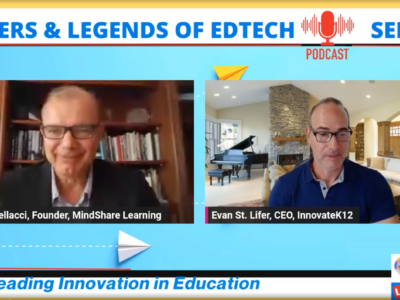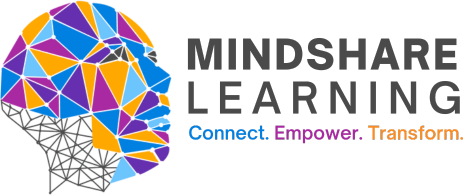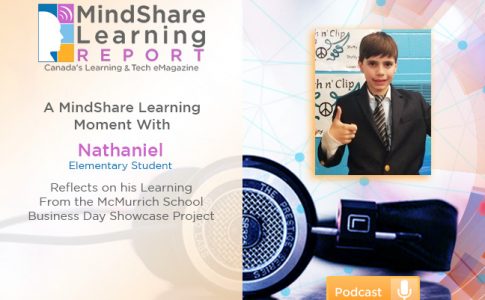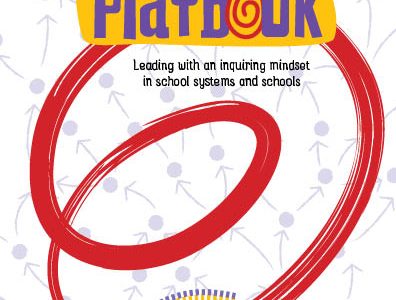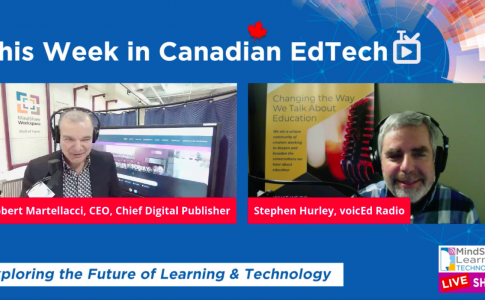This blog has been written in collaboration with Lisa Anne Floyd, PhD Student, Western University, and Dr. Karen Grose, Associate Partner, MindShare Learning. It is the first in an exciting and thought-provoking three-part series. In September, Lisa and Karen outline the relevance, impact and implications of global emerging technologies. In October, they discuss practical ways teachers can critically consider the application of these new technologies with their students in classrooms. In November, they examine the algorithms that impact students as they engage with social media and online games.
Emerging Technologies – Necessary Disruption
While many aspects of our lives have been directly impacted by new technologies, other parts of our lives may have been on the cusp of this disruption. But as digitalization becomes more pervasive, this will no longer be the case. Technology-driven disruption is redefining the way we learn, work, play, live, consume and communicate. These technologies include, yet are not limited to: artificial intelligence (AI), the Internet of Things (IoT) and Big Data. Understanding how these technologies are fueling the digital transformation in education, business, industry and our everyday lives has become a necessity.
As educators, we may ask: How do these new technologies influence K-12 education? What do these new technologies mean to teaching and learning in our elementary and secondary classrooms? Are there best practices for teaching students about these technologies? When we discussed this together, we came up with a simple acronym to guide our thinking: ARII – Awareness, Relevance, Impact and Implications.

What Are These Technologies and How Are They Relevant?
Artificial Intelligence-Better known as AI, artificial intelligence involves computers simulating human intelligence through a number of processes that may include learning and reasoning. Whether you see AI as the end of the world as we know it, or the beginning of a more promising future, AI currently impacts our students’ lives, our society and the global community.
Internet of Things-The IoT is a multi-billion dollar industry that involves connecting devices we might use on a regular basis such as coffee makers, garage door openers, and refrigerators, to the internet. With IoT, pretty much any “thing” can incorporate sensors to collect data, which can then share information with other “things” or computers. IoT results in more automation, resulting in many parts of our lives becoming more efficient, reliant on technology, but also freeing us up to focus on other tasks.
Big Data-Because of improvements in the way data is stored and processed, our pervasive use of the internet and easier access to sensors, we now have millions of data points to consider in decision-making. Computers are able to make decisions by incorporating advanced algorithms to process this huge amount of data, with very high prediction rates. Big data can potentially improve and save lives.
What Are the Impact and Implications of These Technologies?
Each of AI, IoT and Big Data overlap with one another and have begun to impact our lives across various industries.
Automotive
Automation and Self-driving cars – Consider how important it is for a car’s sensor and computer system to distinguish between a plastic bag blowing in the wind or a person on a bike appearing in front of a moving vehicle. Many sensors and thousands of points of data are taken into account as the car makes decisions about when to slow down, stop suddenly, swerve or keeping going. The implications of misinterpretation could be deadly.
Smart bridges containing sensors that can detect vibrations, temperature differences and cracks are replacing older bridges. Oncoming vehicles could be alerted to slow down due to icy conditions or engineers will know when they need to replace parts or shut a bridge down before a catastrophe happens.
Smart Cities will only become smarter and more efficient as we see further advancements in technologies. Traffic flow can be improved with traffic light sensors, which can then adjust the sequence of the light changes to ensure traffic moves more efficiently. In some cities, apps are being used to inform city engineers of sudden drops in the road, as detected by drivers’ phones. If multiple drops occur at the same location, crews can then be sent out to repair potholes.
Environment
Image and facial recognition apps have improved tremendously over the last few years as a result of improvements in AI algorithms. Scientists can now use various sensors connected to the internet and AI to assist with counting endangered animal species rather than tagging. Scientists can save time, money and reduce stress on organisms and monitor the health of ecosystems.
Health-Related
Computer-aided devices for image recognition and disease detection have been able to detect the appearance of abnormal cell growth by analyzing brain scans sooner than even the most educated and experienced human eye. By discovering tumours sooner, possibly even before they appear, thousands of lives can be saved.
The prevalent use of smart fitness devices is contributing to the collection of millions of data points, which can then be analysed to look for patterns in heart rhythms that may result in deadly heart conditions. The shear amount of data has made AI algorithms more accurate and users can be alerted to seek medical care before a heart attack may occur. Wearable technology has also been used in sports to inform trainers and coaches of player exhaustion, possible concussions and strains. Some apps have even successfully analysed user behaviour to predict depression, even before the user recognizes any symptoms.
The rise in preventive measures in the health industry, as a result of emerging technology, will continue to not only save lives, but also millions of dollars in treatment.
Agriculture
Farmers who have access to these emerging technologies are benefiting in many capacities. Sensors can detect precise soil moisture, pH and nutrient levels. Precise amounts of water and fertilizer can then be applied for crop management. Tractors can be run remotely on GPS, so they are not overlapping their fertilizer or water dispersal and wasting product. Automated milking of cows can help to follow their natural rhythm, reduce costs, and provide important data. Smart Farms will result in greater efficiency, healthier animals and crops, and less waste.
Education and work productivity
Facial recognition algorithms can do more than just recognize faces – they can also recognize emotion on faces. Perhaps our computers can start paying attention to our facial expressions and recognize when we need to take a break, have a snack or stop working for the day, thereby improving productivity. This same software could be used in online learning to support teachers, course designers and developers in their efforts to monitor engagement with online activity.
It is not enough for educators and students to simply survive the new reality of these technologies. Together, we must learn to embrace a future with technology and to thrive in a constantly changing and fast-paced global landscape. More importantly, we need to embrace technology that spurs creativity, inclusivity and equity and that harnesses digitalization to ensure it is serving a greater common good.
References and links to explore these ideas and impacts further:
Artificial Intelligence Explained –
https://searchenterpriseai.techtarget.com/definition/AI-Artificial-Intelligence
Self-Driving Cars –
https://www.economist.com/graphic-detail/2018/03/02/self-driving-cars-need-plenty-of-eyes-on-the-road
Endangered Species –
https://news.microsoft.com/on-the-issues/2019/08/06/ai-endangered-species/
Crowdsourcing and Road Conditions –
https://www.wired.com/insights/2014/03/potholes-big-data-crowdsourcing-way-better-government/
Depression and Apps –
https://www.technologyreview.com/s/530876/this-phone-app-knows-if-youre-depressed/
Smart Farms –
https://medium.com/sciforce/smart-farming-or-the-future-of-agriculture-359f0089df69
https://www.lely.com/ca/en/solutions/milking/
Smart Bridges –
https://www.popularmechanics.com/technology/infrastructure/a24094/smart-bridge-sensors-tidal-generator/
Emotion Recognition –
https://www.digitaltrends.com/cool-tech/rise-of-emotion-tracking-tech/

